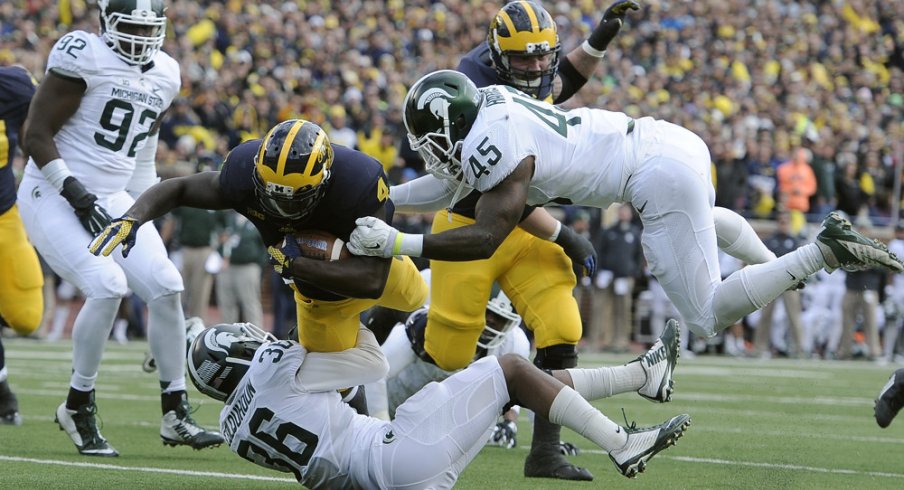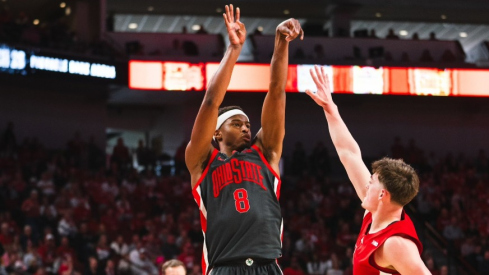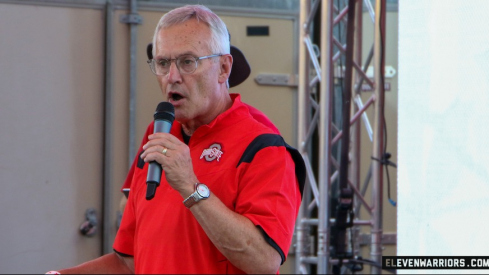When the Ohio State offense looks out upon their opponents Saturday afternoon, they should be struck with a feeling of familiarity.
Although the past three matchups between the Buckeyes and Spartans have all been memorable, the Michigan State defense won’t be recognizable just for the names and faces lining up across from them, but rather because what they do is so similar to what the team in Scarlet faces every day in practice.
It’s well known that after losing to the Spartans in 2013, head coach Urban Meyer brought in co-defensive coordinator Chris Ash to implement a system identical to the one that had just beaten his team. Ash and the OSU defense were so successful with the scheme that former MSU coordinator and current Pittsburgh head coach Pat Narduzzi proclaimed over the summer that his scheme had just won a national championship. While many bristled at the thought at first, it’s almost impossible not to see just how similar the two squads really are when watching closely.
Both teams run a base, 4-3 over alignment with “Quarters” coverage in the secondary. Both teams feature talented and athletic defensive lines anchored by a superstar end. Even on third downs, both units regularly call for three-man lines, bringing a variety of zone blitzes bringing pressure from every direction while running relatively conservative coverage behind it.
However, when watching the 2015 version of the Spartan defense, something just seems…off. After showcasing some of the best pass defense in the nation in 2012 and 2013, MSU now finds itself sliding further and further behind the pack after giving up 300+ yards on four different occasions this year, including to by pedestrian offenses like Western Michigan and Nebraska.
| Year | Yards-per-attempt | yards-per-game | YPG national Rank |
|---|---|---|---|
| 2012 | 5.4 | 175.8 | 9th |
| 2013 | 5.2 | 165.6 | 3rd |
| 2014 | 5.7 | 227.3 | 61st |
| 2015 | 7.5 | 243.0 | 86th |
Thanks to perhaps the most athletically gifted defensive line in head coach Mark Dantonio’s tenure, and an extremely aggressive approach, the Spartans have still been able to live up to their reputation as a very good run-stopping unit statistically, ranking 18th nationally. Yet Rutgers and Purdue have been able to run the ball with success against the unit, showing some chinks in the armor.
The name at the top of the marquee for this squad is unquestionably Shalique Calhoun (#89), the long and lean 6’6” end who was named conference defensive linemen of the year in 2013 and has 25 career sacks. However he’s joined by a pair of former five-star recruits in senior Lawrence Thomas (#8) at the opposite end and Malik McDowell (#4) at nose who, with a similar build to Calhoun, provides a unique challenge to many interior linemen. The fourth and final member of the starting unit is tackle Joel Heath (#92), who is also listed at 6'6" but has the frame of a more traditional defensive tackle.
Behind them you’ll find the latest in a long line of Bulloughs to play linebacker, Riley (#30), who mans the middle and leads the team in tackles. Bullough and fellow inside ‘backer Jon Reschke (#33) will attack the inside ‘A’ gaps regularly, letting McDowell and Heath use their quickness to penetrate the line and make plays in the backfield.
This philosophy differs from that of Ohio State, as the Buckeyes like to keep their linebackers away from the line, with time to read backfield action without having to shed blocks. Neither idea is wrong, as MSU has had great success with their style as McDowell has 10.5 tackles-for-loss in his first year as a starter. But it can also lead to the linemen taking themselves out of plays as they did here when Oregon ran a front-side Power scheme much like the one Ezekiel Elliott used to gash slanting fronts early in the year for OSU.

The biggest play-maker in the back-seven for the Spartans though is unquestionably 'Star' Darien Harris (#45), who is second on the team with 65 tackles. Harris plays a similar role to OSU’s Darron Lee, playing both the run in the box and short passes in the alley with seaming ease in a hybrid role acting as both linebacker and defensive back.

As we can see though, Harris is very quick to jump inside run-action, something he’ll see quite a bit from J.T. Barrett, Elliott, and the Buckeyes. Much as was the case in the 2013 Big Ten Championship, the Spartans will likely line up Harris in the slot to invite the run before crashing the linebacker inside to create a mathematical advantage for the defense.
Knowing the defense will have an extra defender coming inside in the form of Harris and/or a safety, Ohio State will likely look to gain a numerical advantage by using the double-tight end package of Nick Vannett and Marcus Baugh that has seen quite a bit of playing time since Barrett re-gained the starting job. Not only does the additional blocker on the line counter the crashing outside linebacker or safety in the box, Barrett’s ability as a runner changes the math in favor of the offense.
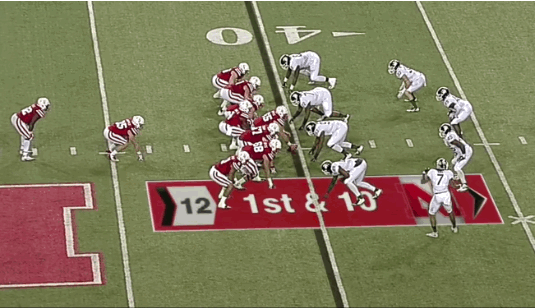
Though Nebraska ran this Outside Lead-Zone from an I-formation, the principle is no different than Barrett carrying the ball outside behind lead-blocks from Elliott and his tight ends. This has been a very popular play-call for OSU this fall, and one we can expect to see a great deal of this weekend as the quarterback now has eight blockers to run behind.
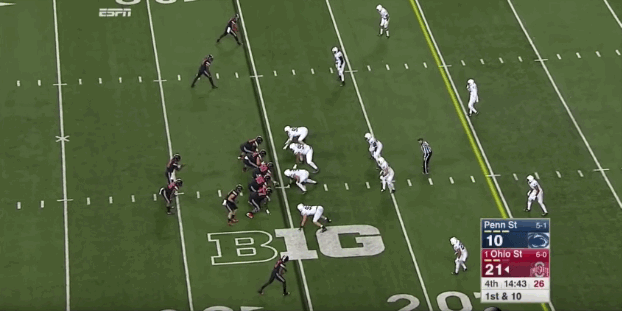
Even when Harris doesn’t bite inside on run-action though, teams have tried to re-equate the numbers in the run game by simply optioning the disruptive Calhoun instead of blocking him. Oregon did so numerous times in their September matchup, both with run and pass options.

Yet packaged screen passes are only a small part of MSU’s real issue on defense, the aforementioned pass defense. With a defender like Harris playing so aggressively against the run, safeties Demetrius Cox (#7) are Montae Nicholson (#9) are often responsible for the slot receiver to their side in what becomes solo coverage after the receiver releases more than five yards downfield. Both players are bigger defensive backs and have had trouble keeping up with shifty receivers in space.

The Buckeyes torched Spartan safeties last fall in East Lansing by singling them out against the much faster Devin Smith, who lined up in the slot consistently that night. With normal slot receivers Braxton Miller and Curtis Samuel new to the position, we may see the Buckeyes bring Jalin Marshall in short motion from the outside before the snap, acting the #2 receiver inside and becoming the safety’s responsibility in deep coverage.
But what has truly led to the downfall of Sparta's once-great pass defense has not been the play of their safeties. Instead, after losing talented cornerbacks like Darqueze Dennard and Trae Waynes to the NFL over the past few years, their replacements have yet to live up to those same standards.
Though quarters is a zone in theory, once a receiver releases vertically more than five yards downfield, the concept becomes man coverage. Against this scheme, offenses have begun singling out current corners Darian Hicks (#2) and Arjen Colquhoun (#36) by spreading the entire width of the field and running vertical routes, often leaving the defenders in the dust.

Additionally, offenses will force the defense into a solo coverage simply with the use of formation. By placing three receivers to one side, the back-side safety is theoretically responsible for the #3 inside receiver if he releases downfield, meaning he can't help with any vertical threats from the other side. In this instance, the corner will make a "MEG" call, meaning Man Everywhere he Goes.
While the Spartan corners have trained for these situations, they've yet to face perhaps the conference's most talented route-runner in Michael Thomas. The big Buckeye receiver has made a habit of abusing defenders that try to cover him alone this fall, and we can expect him to line up alone on one side quite frequently Saturday, forcing the MSU corners into these MEG calls.
Yet the Spartans still have some hope at slowing down the Buckeye offense, thanks to Calhoun and their dynamic front. By this point it's become obvious that the Ohio State offensive line has had some issues with pass protection on the right side, specifically with right tackle Chase Farris.
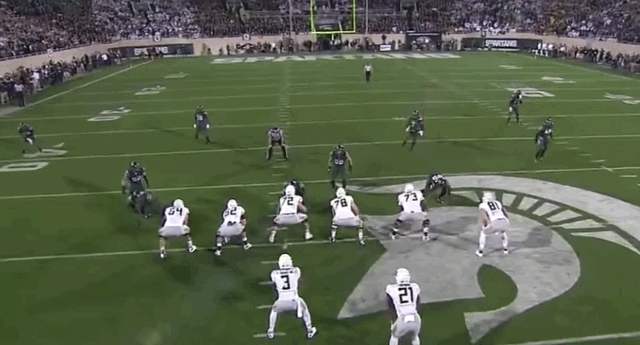
The Spartans have shown that they'll bump their entire front over to get Calhoun in one-on-one situations against a less-talented player, and the Buckeyes will have to adjust.
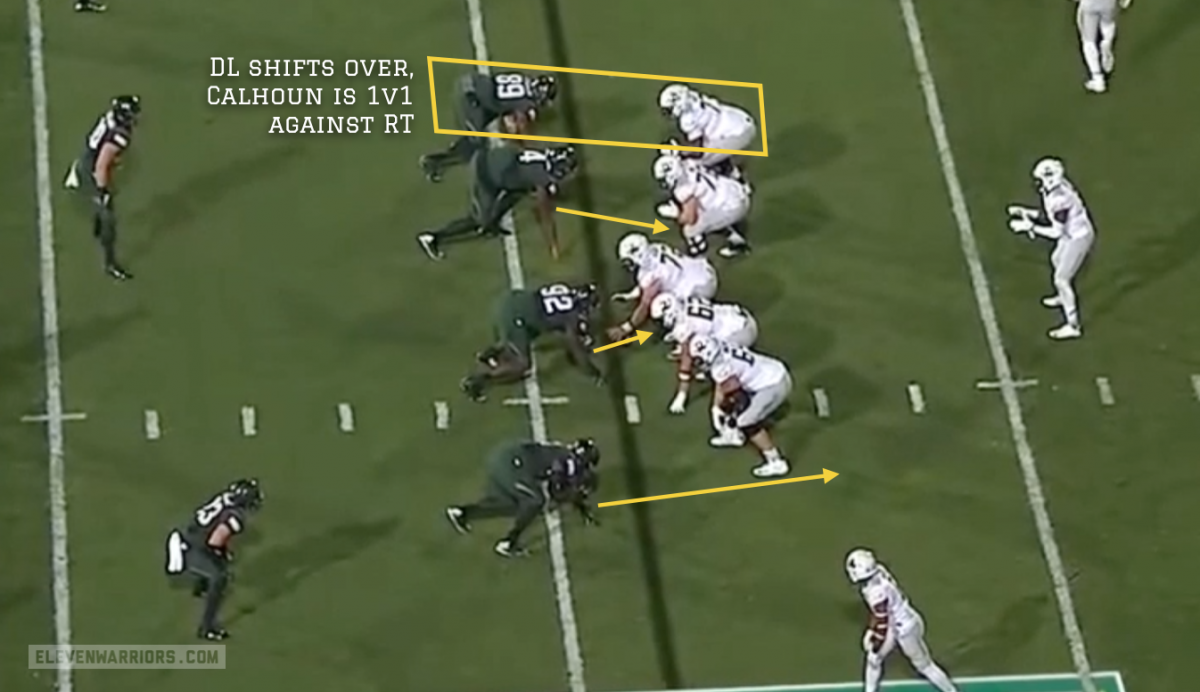
Barrett had success rolling out to his left, away from the constant pressure brought by the Illinois defense last week, hitting his receivers for a couple first downs. This, along with help from an excellent blocker in Ezekiel Elliott, will be crucial for Barrett to have any chance at getting passes off on early downs.
However once an offense faces third down, the Spartans really turn up the heat with a multitude of zone blitzes, bringing six rushers while leaving five in coverage downfield.
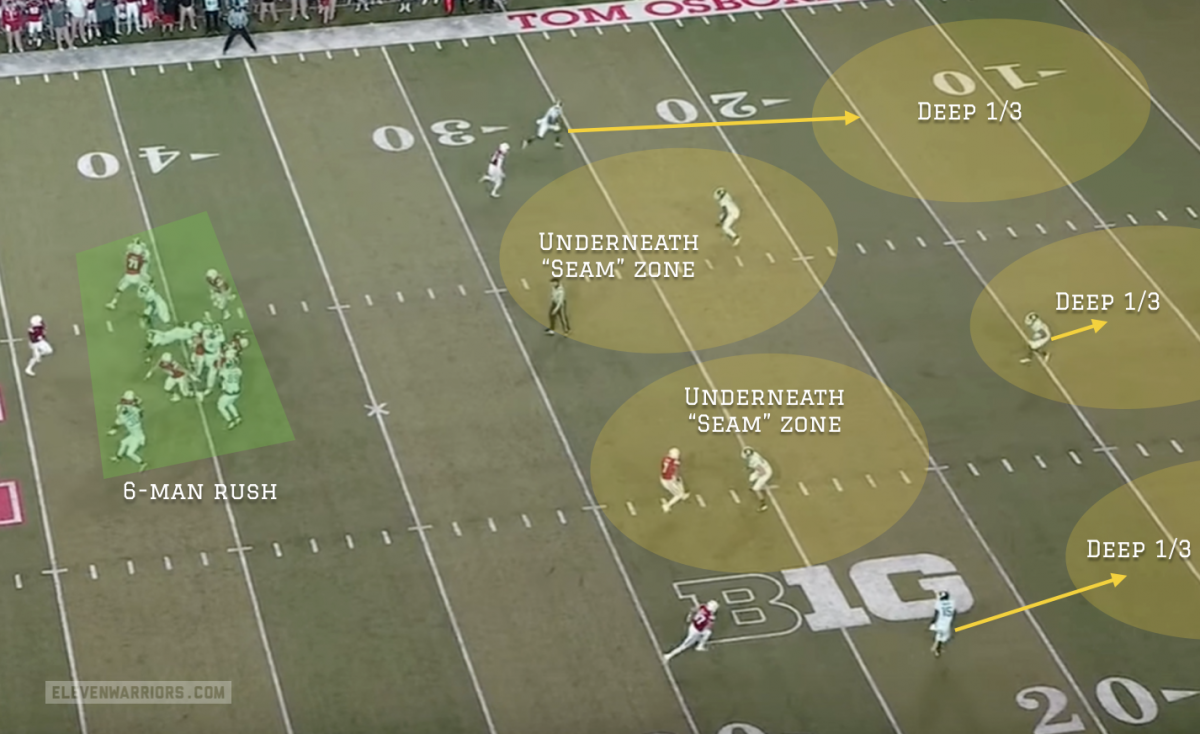
Unlike the Buckeyes though, the MSU defense will bring pressure from all different angles, often blitzing defensive backs from the edge and replacing them with a linebacker in coverage. The result is a consistently successful pass rush that has brought down opposing quarterbacks 29 times this fall, the 14th-best total in the nation.
Though the numbers may show that this version of the Michigan State defense isn't what we're used to seeing from them, they're still very dangerous. But if the 'slobs' are able to control the line of scrimmage, we could see a result very similar to the one we saw in East Lansing a year ago.
